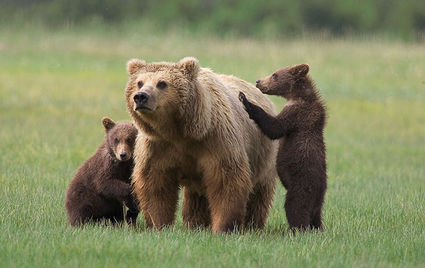Ursus Horribilis aptly named
June 21, 2017
The Latin name for a grizzly bear is Ursus Horribilis and it gets that name because it is one of the few animals in the world that exhibited not the slightest fear of man in many situations and it was only after the great hunting guns were invented did man have much of a chance against the grizzlies.
Montana has always been grizzly bear country but for many people the notion of those great bears out here on the prairie was unbelievable. Grizzlies belong in Yellowstone to a small degree but mainly in the Northern Eco System which includes Glacier National Park, Waterton and the three great wilderness systems that spread south from Glacier.
Many people do not know that grizzlies were for generations a bear that lived on the prairie. Where we walk and plow the ground today, great grizzlies lived until well after Lewis and Clark came up the Missouri and on to the Pacific Ocean.
When a person reads of the great portage that Lewis and Clark and their men had to endure to get around the several great falls of the Missouri, Lewis, I recall, got attacked by a grizzly and the entire crew fought grizzlies, rattlesnakes and prickly pear cactus where downtown Great Falls is today. Matter of fact of those three demons, the men said that the cactus was the worst and caused them to have to have new moccasins made for them almost daily at that time.
As homesteaders and ranchers took over the prairie, the great bears moved into the mountains and used that for a habitat for more generations.
However, in that habitat they were so protected that their population grew in leaps and bounds so now we find a couple of interesting things happening. First, young grizzlies are very interested in exploring their old prairie habitat. Most experts say that is probably happening as conditions in the northern eco system are crowding some bears out. And, when a mother grizzly raises her cubs in the Front Range or out in the prairie, those cubs are more liable to stay on the prairie then go back into the Rocky Mountains.
To make conditions worse, it seems there is a conservation ranch that feeds hungry grizzlies on the prairie just east of the Front Range. They get lots of takers as bears seem to hibernate in that area and come out in the spring, hungry.
So what you might say. What does this have to do with people living in Big Sandy?
Simple. The bears are getting closer to us all the time.
Even though there have never been grizzly bears in the Bear Paw Mountains during my lifetime, there have been maybe a dozen sightings of black bears through the years and with the Bear Paw habitat being what it is, and with young male grizzlies coming down the Missouri drainage, it is just a question of time before grizzlies get to the Missouri breaks, the Highwoods and the Bear Paw Mountains.
Just last week Montana Fish, Wildlife and Parks reported that there were a couple of young grizzly bears sighted between Ryan and Morony Dams just east of Great Falls.
To quote Montana Fish, Wildlife and Parks, "In recent years bears have traveled the river corridors, Sun, Marias, Dearborn and Teton east from the Rocky Mountain Front looking for natural foods. But the animals can also be attracted to unprotected opportunistic foods like grain, livestock feed, beehives, livestock, garbage and pet food."
So, when recreating or living on the prairies near a river system, be careful to not leave food, even bird food, around for a bear to get into. And, most of all be careful and remember that those bears are named Ursus Horribilis for good reason!
And if they are not here now, they will be.






